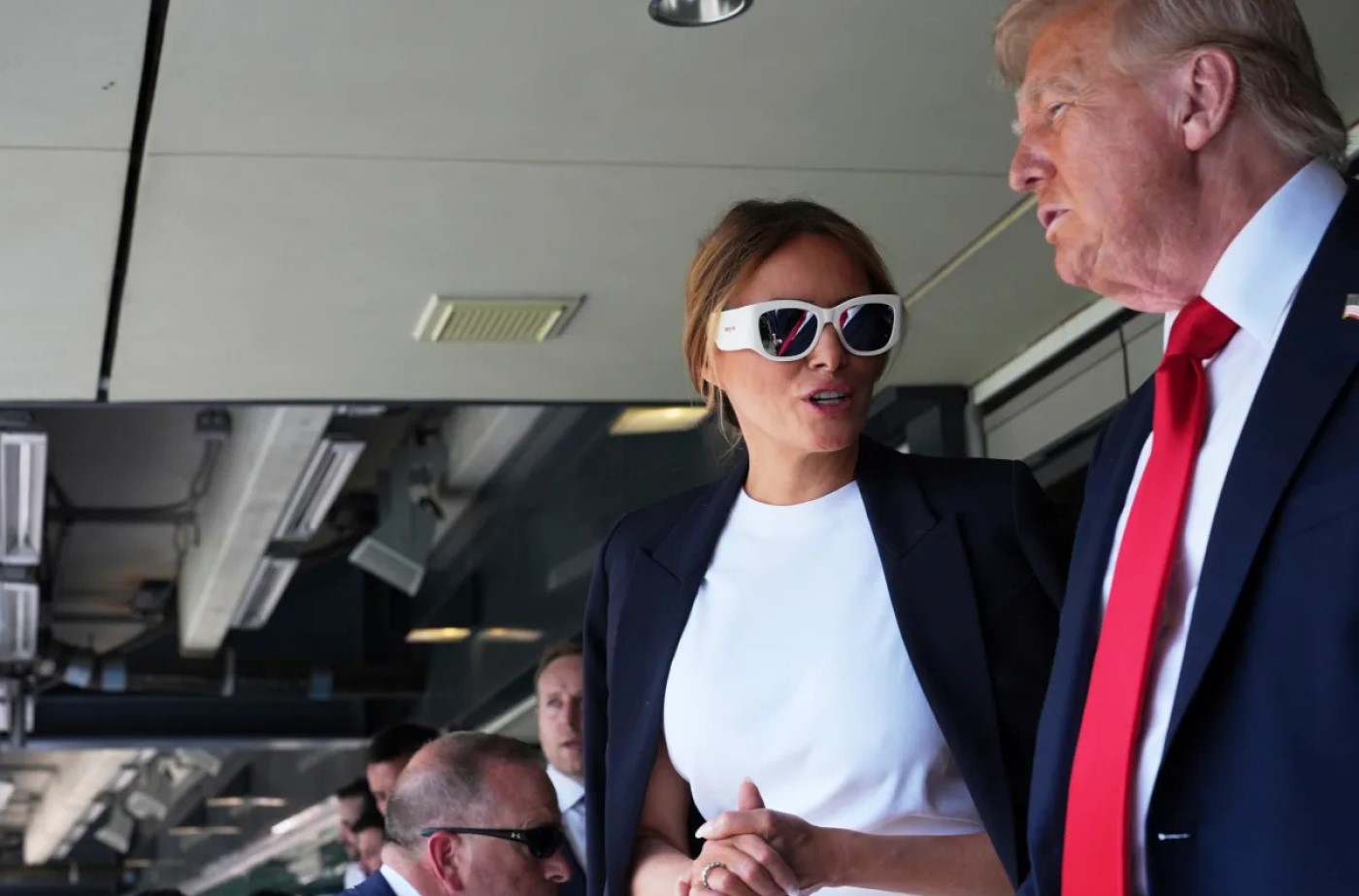Sometimes a sporting event transcends the boundaries of the field, becoming a stage for moments that reveal deeper tensions within society. What was meant to be a celebration of athletic excellence and international competition instead became a complex tableau of political discord, awkward social dynamics, and unscripted human drama. The night of July 13, 2025, at MetLife Stadium will be remembered not just for the soccer played, but for the uncomfortable truths it exposed about power, protocol, and public sentiment in modern America.
The Stage: More Than Just a Soccer Match
MetLife Stadium: A Fortress of Football Transformed
The FIFA Club World Cup Final at MetLife Stadium in East Rutherford, New Jersey, represented far more than a typical sporting event. This wasn’t just any soccer match—it was the culmination of FIFA’s premier club competition, bringing together Europe’s elite teams Chelsea FC and Paris Saint-Germain in a battle for global supremacy.
MetLife Stadium, typically the domain of the New York Giants and New York Jets, had been transformed into a soccer cathedral for the evening. The 82,500-seat venue, one of the largest and most technologically advanced stadiums in the world, provided a fitting backdrop for what FIFA had positioned as a showcase of the beautiful game’s global appeal.
The choice of venue was strategically significant. Located in the heart of the New York metropolitan area, MetLife Stadium offered FIFA access to one of the world’s most diverse and soccer-passionate populations. The stadium’s proximity to Manhattan also ensured maximum media coverage and celebrity attendance, factors that would prove more consequential than anyone anticipated.
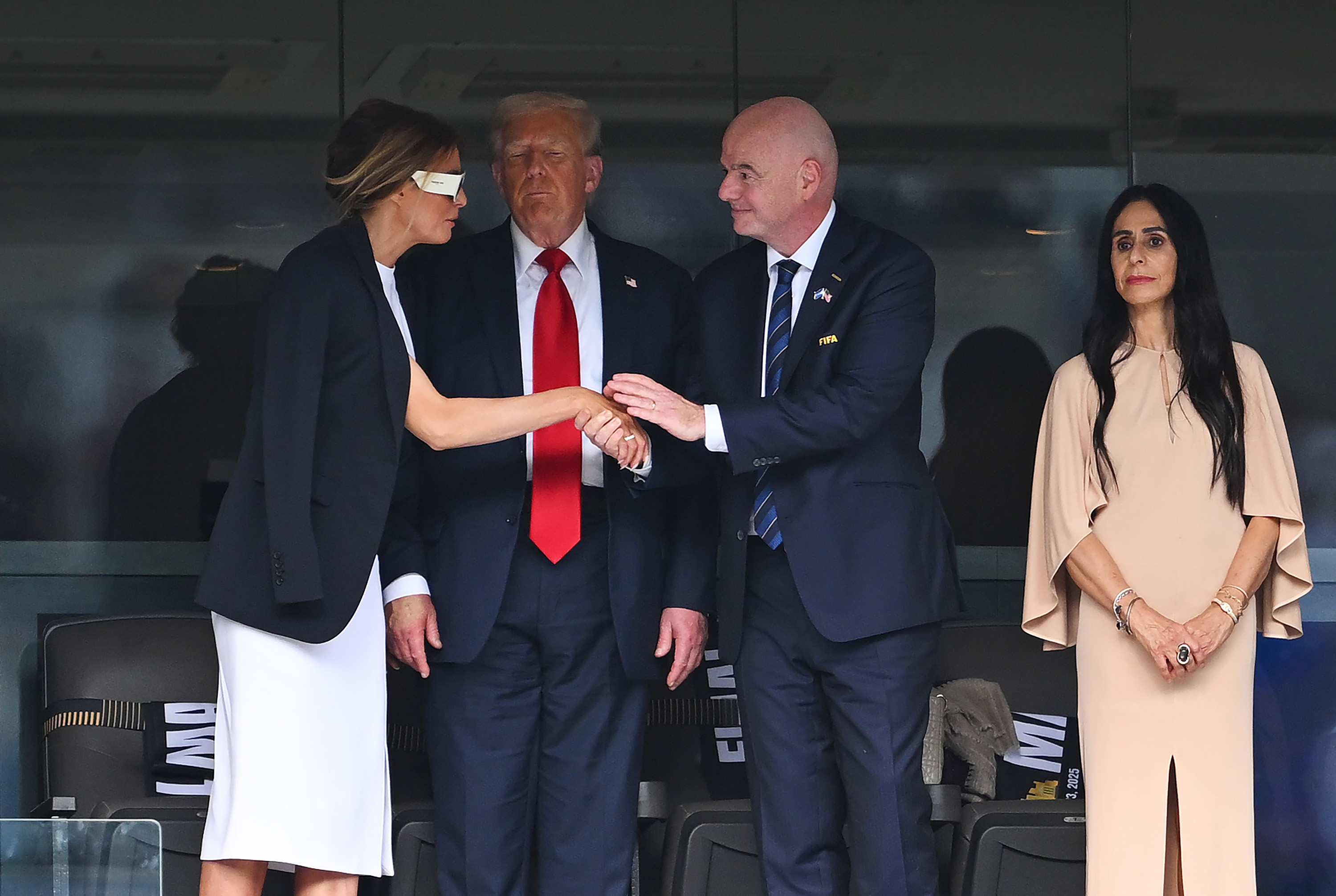
First Lady Melania Trump, President Donald Trump, and FIFA President Gianni Infantino during the FIFA Club World Cup final on July 13, 2025. | Source: Getty Images
For FIFA, this final represented a crucial opportunity to further establish soccer’s foothold in the American sports landscape. The organization had invested heavily in promoting the Club World Cup as a premier global event, hoping to rival the excitement generated by the traditional World Cup while showcasing club soccer’s elite talent.
The Teams: European Powerhouses on American Soil
The matchup between Chelsea FC and Paris Saint-Germain brought together two of Europe’s most storied and controversial clubs. Chelsea, the London-based team with a complex ownership history and a trophy cabinet filled with Premier League and Champions League victories, represented English soccer’s global ambitions.
Paris Saint-Germain, the Parisian club backed by Qatari investment and home to some of the world’s most expensive players, embodied the modern reality of soccer as a global entertainment product rather than merely a sport. The presence of superstars from both teams guaranteed international attention and provided FIFA with the kind of marquee matchup that justifies the Club World Cup’s existence.
The game itself would prove to be an entertaining affair, but it would be overshadowed by events in the VIP suites and on the presentation stage that revealed uncomfortable truths about the intersection of sports, politics, and celebrity culture in contemporary America.
The Presidential Presence: When Politics Invaded Soccer
An Unexpected Guest of Honor
President Donald Trump’s attendance at the FIFA Club World Cup Final was not entirely unprecedented—American presidents have long used sporting events as opportunities for public appearances and diplomatic engagement. However, the timing and context of his appearance created a perfect storm of political tension and public scrutiny.
The decision to attend the match came during a particularly challenging period for the Trump administration. Multiple domestic crises were demanding presidential attention, including ongoing wildfire emergencies in Texas and other pressing national issues. Critics immediately questioned the appropriateness of attending a soccer match while American communities faced emergency situations.
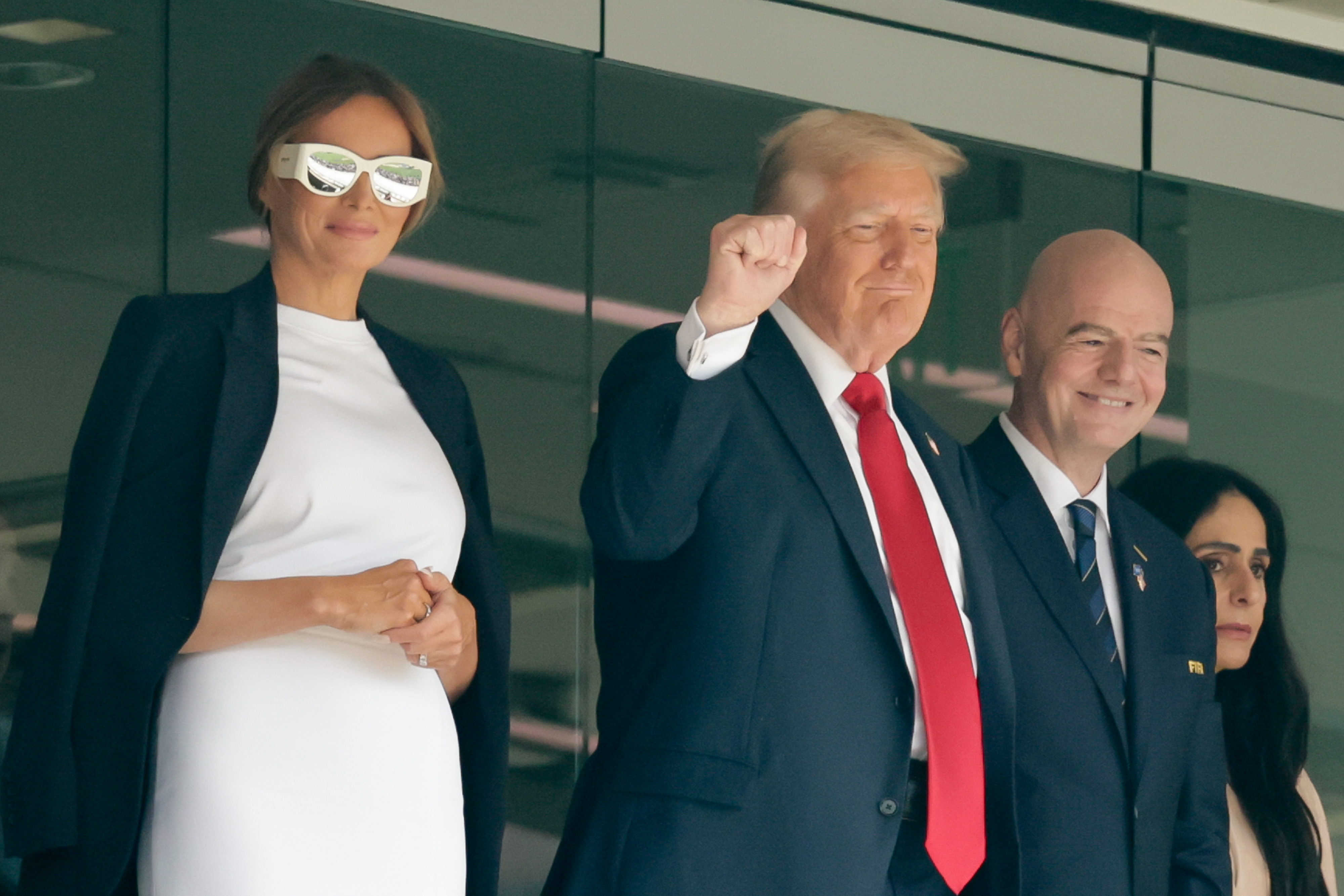
Source: Getty Images
Trump’s presence at the event was part of a broader pattern of using high-profile sporting events to project strength and normalcy during difficult political periods. However, this strategy would prove problematic when faced with a hostile audience and unpredictable live television coverage.
The VIP Suite: Power Dynamics on Display
The composition of the presidential party in the VIP suite revealed important insights into both FIFA’s political relationships and the Trump administration’s approach to international sports diplomacy. Alongside President Trump and First Lady Melania Trump, the suite hosted FIFA President Gianni Infantino and his wife, Leena Al Ashqar, creating a tableau of international sports politics.
Gianni Infantino’s presence alongside Trump was particularly significant given FIFA’s complex relationship with American politics and law enforcement. The soccer organization had been working to rebuild its reputation following years of corruption scandals, and maintaining positive relationships with major political figures was seen as crucial to that effort.
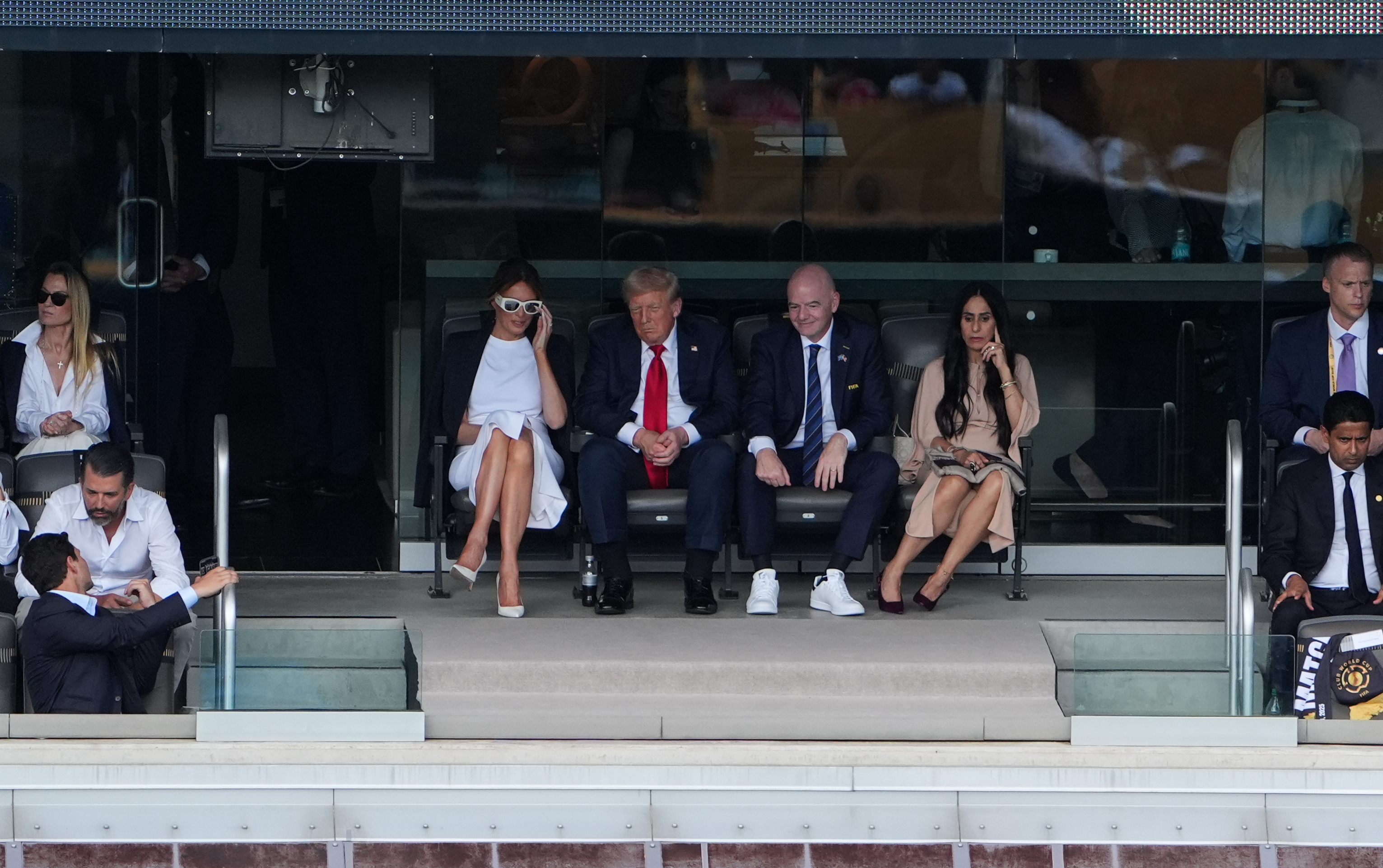
Melania and Donald Trump with Gianni Infantino and Leena Al Ashqar during the FIFA Club World Cup 2025 final match between PSG and Chelsea at MetLife Stadium on July 13 in New Jersey. | Source: Getty Images
The sight of the American President and FIFA President together sent messages about the growing importance of soccer in American culture and the Trump administration’s willingness to engage with international sports organizations. However, these diplomatic considerations would soon be overshadowed by more immediate concerns about crowd reaction and public perception.
Also present in the presidential party was Donald Trump Jr. and his girlfriend Bettina Anderson, whose own behavior would contribute to the evening’s collection of memorable moments. The extended Trump family presence suggested that this was seen as both a political opportunity and a social occasion.
The Crowd’s Verdict: Democracy in Action
The National Anthem Incident
The first sign of trouble came during what should have been a moment of patriotic unity. The playing of the national anthem at sporting events has become one of the most politically charged moments in American sports, carrying weight far beyond its ceremonial origins.
Unlike previous games in the tournament, where the anthem had been played well in advance of kickoff when the stadium was less full and attention was focused on pre-game activities, this performance was strategically timed to coincide with Trump’s presence and maximum television viewership.
When the stadium’s massive video boards showed President Trump standing for the anthem, the crowd’s response was immediate and unmistakable. Loud boos erupted throughout the stadium, lasting for several seconds and creating an audio backdrop that television microphones could not ignore.
This reaction was particularly significant because it occurred during the national anthem—traditionally a moment when political differences are set aside in favor of patriotic unity. The fact that the crowd was willing to voice disapproval during this solemn moment suggested deep-seated opposition that transcended typical political discourse.
The booing during the anthem also created an uncomfortable situation for television broadcasters, who found themselves covering a moment of political discord during what was meant to be a celebration of American patriotism. The incident highlighted the challenges of separating sports from politics in contemporary America.
The Geography of Dissent
MetLife Stadium’s location in the greater New York metropolitan area likely contributed to the hostile reception Trump received. The region has historically been Democratic-leaning, and Trump’s complicated relationship with New York—his former home base—added personal dimensions to the political opposition.
The crowd composition also reflected soccer’s demographic appeal in America. Soccer fans tend to be younger, more diverse, and more internationally minded than fans of traditional American sports. This demographic profile suggested an audience potentially more opposed to Trump’s political positions and more willing to express that opposition publicly.
The sold-out nature of the event meant that the crowd reaction came from over 80,000 people, creating a volume and intensity of opposition that could not be dismissed as the work of a small, vocal minority. The sustained nature of the booing throughout multiple moments of the evening demonstrated organized and widespread disapproval.
The Kiss: A Moment of Intimacy Under Scrutiny
Melania’s Calculated Affection
In the midst of political tension and crowd hostility, cameras captured what appeared to be a spontaneous moment of marital affection between President Trump and First Lady Melania Trump. The image of Trump leaning in to kiss his wife on the cheek while standing alongside FIFA officials would become one of the most widely circulated photos from the evening.
However, in the context of ongoing speculation about the Trump marriage and Melania’s comfort with public displays of affection, this seemingly simple gesture carried additional weight. The kiss occurred while both were aware of being filmed and photographed, suggesting a degree of calculated public image management rather than purely spontaneous affection.
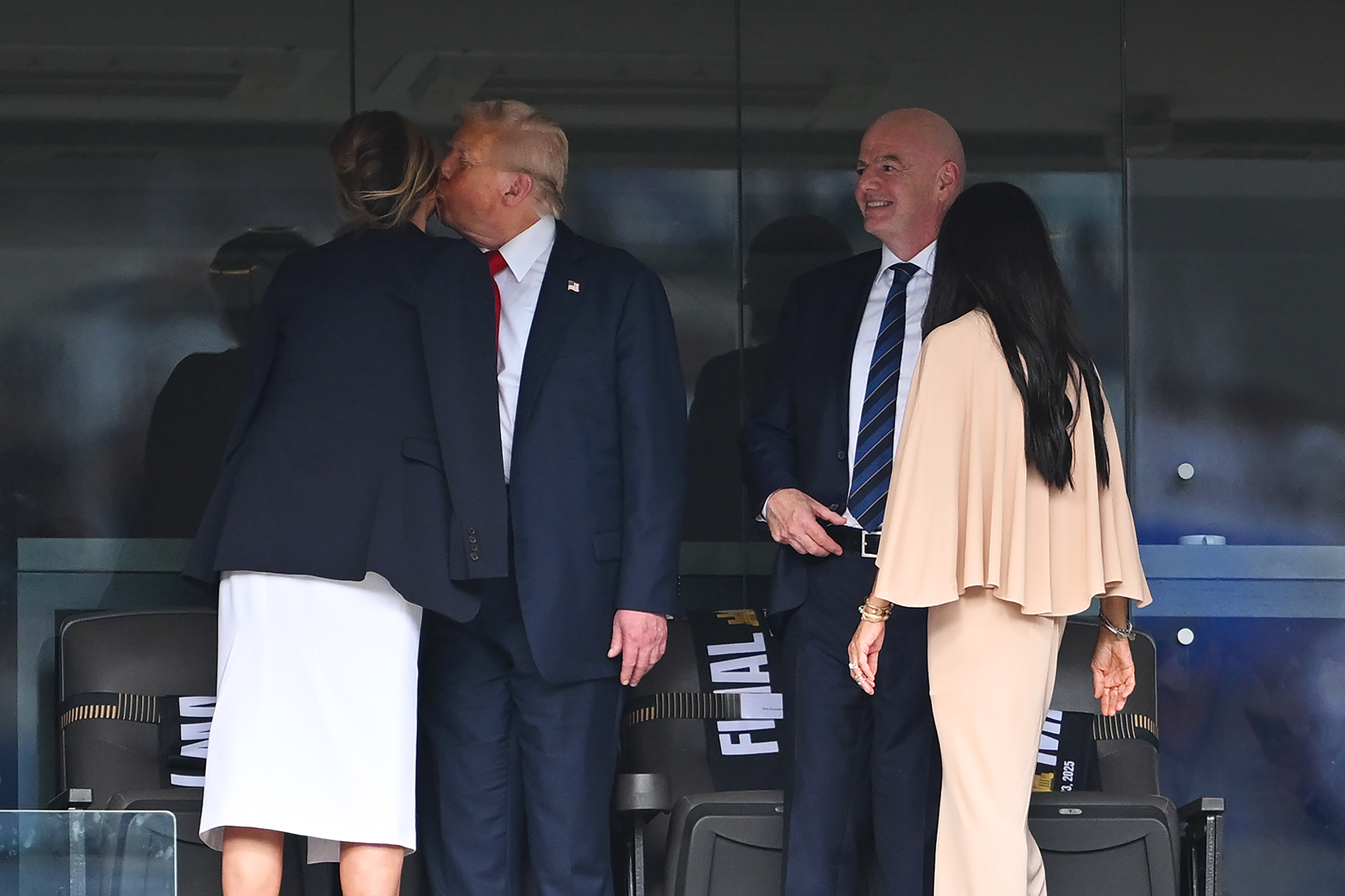
Donald Trump planting a kiss on Melania Trump’s cheek during the FIFA Club World Cup Final on July 13, 2025. | Source: Getty Images
The timing of the kiss was also notable—occurring while crowd hostility was evident and television coverage was focusing on the presidential presence. Whether intentional or not, the moment of marital unity provided a visual counterpoint to the audio of crowd disapproval, creating a complex narrative about private relationships and public personas.
For Melania Trump, who has often appeared uncomfortable with public displays of affection throughout her time as First Lady, allowing this moment to be captured suggested either genuine comfort or recognition of its public relations value. The image would later be analyzed extensively on social media and in news coverage as evidence of the couple’s relationship dynamics.
The Power of Presidential Imagery
The photograph of the kiss exemplified the way presidential imagery can take on meanings far beyond the intended moment. In an era of intense scrutiny of the Trump marriage, any public display of affection between the President and First Lady becomes a data point in ongoing narratives about their relationship.
The presence of FIFA officials in the background of the photo also reinforced themes about international diplomacy and American soft power. The image suggested normalcy and diplomatic success even as crowd reactions told a different story about Trump’s public reception.
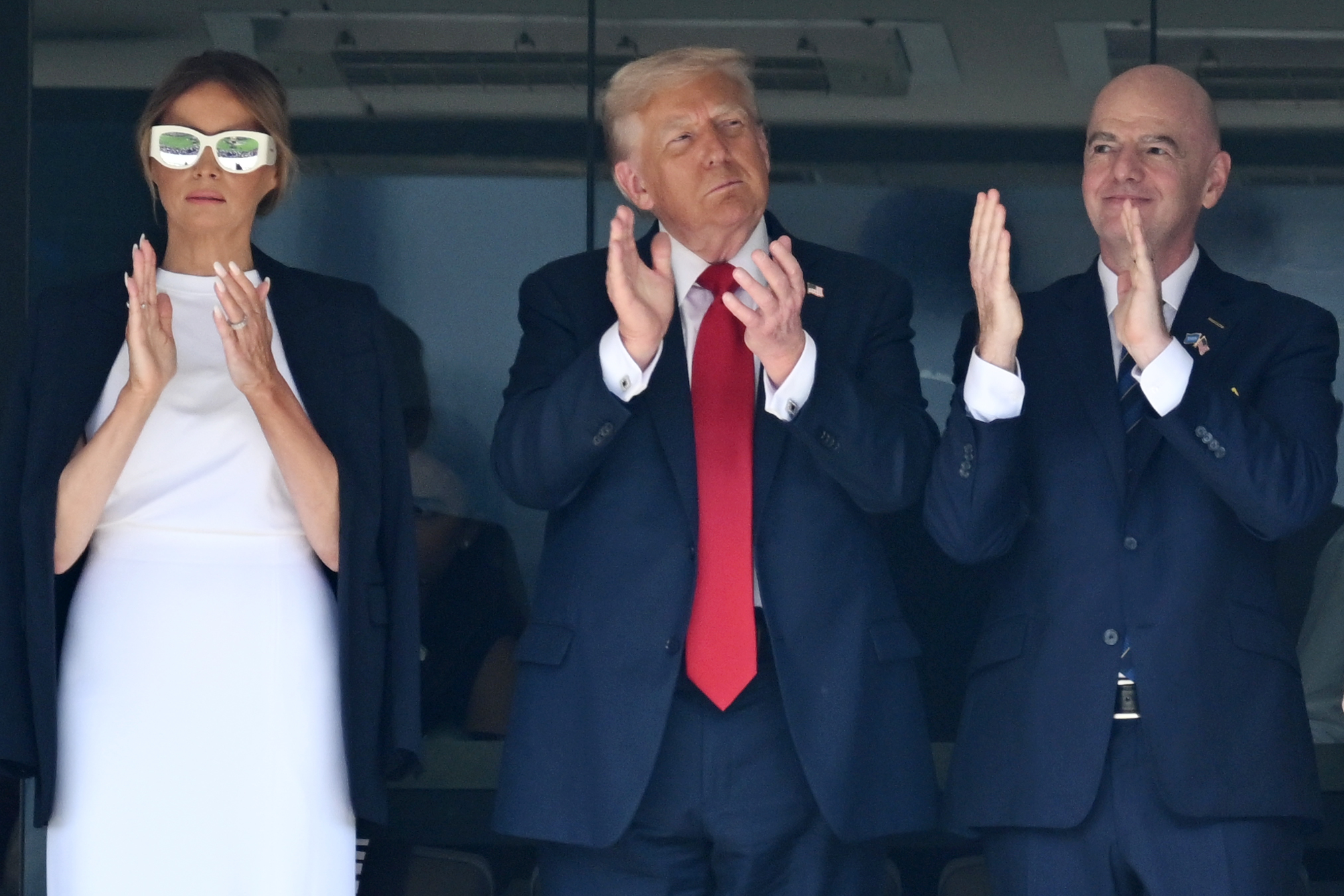
First Lady Melania Trump, President Donald Trump, and FIFA President Gianni Infantino during the FIFA Club World Cup final on July 13, 2025. | Source: Getty Images
The Stage Invasion: When Protocol Breaks Down
Chelsea’s Trophy Moment Hijacked
Perhaps the most awkward and revealing moment of the evening came during Chelsea’s victory celebration. What should have been the team’s moment of triumph became an uncomfortable lesson in the intersection of political power and sports protocol.
After Chelsea defeated Paris Saint-Germain to claim the FIFA Club World Cup, the customary trophy presentation ceremony began. This ritual, familiar to soccer fans worldwide, typically involves officials presenting medals to players and coaches before the winning team’s captain lifts the trophy amid celebration.
However, President Trump’s role in the ceremony extended far beyond traditional protocol. While FIFA President Infantino was expected to guide the proceedings and then step aside, Trump remained prominently positioned throughout the celebration, creating visible confusion among the Chelsea players.
The moment that crystallized this awkwardness came when Chelsea midfielder Cole Palmer, preparing for the traditional trophy lift, turned to team captain Reece James with visible confusion. “Wait, wait, what’s he doing?” Palmer asked, noticing Trump still standing with them on the podium.
James’s follow-up question—”Are you going to leave?”—directed at the President of the United States, represented an extraordinary breach of normal diplomatic etiquette. The fact that professional athletes felt comfortable questioning a world leader’s presence spoke to both the informal nature of sports settings and the genuine confusion about what was happening.
Athletes Navigate Unexpected Diplomacy
The Chelsea players found themselves in an unprecedented situation—trying to celebrate their athletic achievement while managing an unexpected diplomatic encounter. Their training had prepared them for victory celebrations, media interviews, and fan interactions, but not for navigating presidential protocol during their moment of triumph.
Cole Palmer’s later explanation revealed the depth of the confusion: “I knew he was going to be there, but I didn’t know he was going to be on the stand where we lift the trophy. So, I was a bit confused.” This statement suggested that while the team had been informed about Trump’s attendance, they had not been briefed on his extensive role in their celebration.
Reece James’s additional comment—”I thought he was going to exit the stage, but he wanted to stay”—highlighted the disconnect between expectations and reality. The team captain had assumed normal protocol would apply, where dignitaries present awards and then allow athletes to celebrate privately.
The fact that FIFA President Infantino eventually had to step in to guide Trump off the stage suggested that even FIFA officials were struggling to manage the situation. This intervention came only after the awkwardness had become apparent to television viewers and stadium attendees worldwide.
The Trophy Lift: A Crowded Stage
When Chelsea captain Reece James finally lifted the FIFA Club World Cup trophy, the image was unlike typical victory celebrations. Instead of showing triumphant athletes surrounded by teammates and coaches, the photos captured a crowded stage where sports achievement competed with political presence for visual attention.
Trump’s prominent position during the trophy lift meant that Chelsea’s historic victory was visually associated with American political power rather than purely athletic achievement. This association was particularly problematic given the crowd’s hostile reaction to Trump throughout the evening.
The sustained booing that accompanied the trophy presentation created an audio-visual disconnect where images of celebration were accompanied by sounds of disapproval. This contradiction highlighted the complex relationship between sports as entertainment and sports as political platform.
For Chelsea players and fans, having their moment of victory overshadowed by political controversy represented an unfortunate intrusion of external concerns into their sporting achievement. The Club World Cup victory was a significant accomplishment that deserved to be celebrated on its own merits.
The Social Media Backlash: Digital Democracy in Action
Online Outrage and Crisis Context
The criticism of Trump’s attendance at the soccer match extended far beyond the stadium walls, exploding across social media platforms as users expressed outrage about presidential priorities during ongoing national crises. The digital response revealed deep frustrations about leadership during emergency situations.
The most pointed criticisms focused on the contrast between attending a luxury sporting event while American communities faced emergency situations. “He already forgot about Texas…” wrote one social media user, referencing ongoing wildfire emergencies that were demanding federal resources and attention.
Another comment captured the broader frustration: “At a soccer game when everything else is going on in the country.” This sentiment reflected a common criticism of political leaders who appear disconnected from the urgent concerns of ordinary citizens during crisis periods.
The specific reference to Texas was particularly damaging because it highlighted ongoing emergency situations where presidential attention and federal resources were desperately needed. “He should be in Texas feeding the people that lost everything,” wrote another critic, emphasizing the stark contrast between luxury entertainment and emergency response.
The Optics of Presidential Leisure
The visual contrast between Trump enjoying a luxury sporting event and Americans dealing with natural disasters created powerful imagery that his critics were quick to exploit. Social media users shared side-by-side images of wildfire destruction and soccer celebrations, highlighting what they saw as misplaced priorities.
“States are on fire and [he’s] watching soccer ,” wrote one user, employing emojis that captured the tragicomic nature of the situation. The combination of laughter, sadness, and frustration reflected the complex emotions many Americans felt about their leader’s choices during crisis periods.
The international nature of the event also drew criticism from those who felt Trump should be focusing on domestic rather than international concerns. The FIFA Club World Cup, while held in America, was fundamentally about international soccer competition rather than American interests or priorities.
The Speed of Digital Criticism
The real-time nature of social media criticism meant that negative reactions to Trump’s attendance began circulating before the match had even concluded. Twitter, Instagram, Facebook, and other platforms became venues for immediate political commentary that amplified and sustained the controversy.
Hashtags related to the event quickly began trending, with users organizing their criticism around easily searchable terms that helped consolidate opposition and create viral momentum. The digital response demonstrated how modern political criticism can organize and spread faster than traditional media coverage.
The global reach of social media also meant that international audiences were witnessing American political discord in real time. Foreign soccer fans following the Club World Cup were exposed to domestic American political tensions, potentially affecting international perceptions of American leadership and stability.
Family Dynamics: The Trump Jr. Subplot
PDA at the Airport
Before the main event had even begun, Donald Trump Jr. and his girlfriend Bettina Anderson were creating their own headlines with public displays of affection at Teterboro Airport in New Jersey. The couple’s behavior while waiting for the President and First Lady’s arrival added another layer of Trump family drama to an already complex evening.
Dressed in coordinating white button-up shirts, the couple engaged in extensive kissing and embracing that photographers captured in detail. Their apparent obliviousness to the public setting and media presence suggested either genuine affection or calculated attention-seeking behavior.
The airport setting for these displays was particularly notable because it represented a semi-public space where some discretion might normally be expected. The fact that Trump Jr. and Anderson were comfortable engaging in extensive PDA while surrounded by security personnel, media, and other airport users highlighted their comfort with public attention.
The Symbolism of Matching Outfits
The couple’s decision to wear matching white shirts created visual coordination that suggested either careful planning or coincidental fashion choices that photographers were quick to notice. In the context of political family imagery, such coordination often signals unity and partnership.
However, the contrast between their apparent romantic bliss and the political tensions surrounding the family created a complex narrative about private happiness amid public controversy. Their affectionate behavior occurred against the backdrop of ongoing criticism of the Trump administration and questions about the family’s priorities.
The presence of Trump Jr. at the event also raised questions about the extent to which family members were involved in official presidential activities. His attendance suggested that the soccer match was seen as both a political opportunity and a family social occasion.
Media Strategy or Genuine Emotion?
The extensive documentation of Trump Jr. and Anderson’s airport PDA raised questions about whether their behavior was spontaneous or strategically performed for media consumption. The Trump family’s sophisticated understanding of media attention suggested that few public moments were entirely unplanned.
However, the sustained nature of their affectionate behavior and their apparent comfort with each other suggested genuine romantic connection rather than purely performative behavior. The couple had been dating for some time, and their public appearances typically showed consistent comfort with public displays of affection.
The timing of these photos, emerging just as criticism was mounting about the President’s priorities, created an interesting narrative contrast. While Trump Sr. was facing public criticism for his attendance choices, Trump Jr. was generating positive personal publicity through romantic imagery.
FIFA’s Diplomatic Tightrope
Infantino’s Balancing Act
FIFA President Gianni Infantino found himself navigating complex diplomatic waters throughout the evening, trying to maintain positive relationships with American political leadership while managing an increasingly uncomfortable public relations situation.
Infantino’s presence alongside Trump throughout the event reflected FIFA’s ongoing efforts to maintain positive relationships with major political figures following years of corruption scandals that had damaged the organization’s reputation. The soccer governing body needed American political support for various initiatives, including future World Cup preparations.
However, the crowd’s hostile reaction to Trump put Infantino in the awkward position of being associated with an unpopular political figure during what was meant to be a celebration of soccer achievement. His eventual intervention to guide Trump off the stage suggested recognition that the situation had become problematic.
International Sports Diplomacy
The evening highlighted the complex relationship between international sports organizations and national political leaders. FIFA’s need to maintain relationships with powerful countries often requires navigating domestic political controversies that can affect the organization’s global reputation.
For FIFA, the American market represents crucial growth opportunities and revenue potential. The organization has invested heavily in promoting soccer in the United States, and maintaining positive relationships with American political leaders is seen as essential to those efforts.
However, the visible public opposition to Trump’s presence at the event demonstrated the risks of too closely associating with controversial political figures. FIFA’s careful neutrality on political matters was tested by the necessity of working with Trump as the sitting American president.
The Broader Context: Sports and Politics in Modern America
The Politicization of Athletic Events
The FIFA Club World Cup Final incident reflected broader trends in the politicization of American sporting events. From NFL anthem protests to NBA social justice initiatives, sports venues have increasingly become sites of political expression and controversy.
Trump’s attendance at the soccer match occurred within this context of heightened political awareness among athletes and fans. The crowd’s willingness to voice political opposition during a sporting event reflected normalized expectations that sports and politics would intersect.
The incident also highlighted how social media has changed the dynamics of political protest at sporting events. What once might have been confined to stadium attendees now becomes global political commentary through viral videos and real-time social media coverage.
Presidential Sports Appearances: A Complicated Tradition
American presidents have long used sporting events as opportunities for public appearances that can project strength, normalcy, and connection with popular culture. However, the increasingly polarized political environment has made such appearances more risky and potentially counterproductive.
Trump’s experience at the FIFA final joined a growing list of presidential sporting event appearances that became more about political controversy than athletic celebration. The incident demonstrated how traditional presidential privileges and protocols can become sources of criticism rather than popular support.
The evening also raised questions about the appropriateness of extensive presidential involvement in sports celebrations. While presenting awards and attending events is normal, Trump’s extended presence during Chelsea’s victory celebration pushed beyond traditional boundaries.
The International Dimension: Global Audiences and American Politics
Soccer’s Global Reach
The FIFA Club World Cup Final attracted international television audiences who witnessed American political discord alongside soccer competition. This global viewership meant that Trump’s reception became part of international perceptions of American political stability and leadership.
For international soccer fans, the evening provided an unexpected lesson in American political divisions. The sight of an American president being booed during a major sporting event challenged assumptions about political respect and national unity.
The incident also highlighted cultural differences in how political leaders are treated at sporting events. In many countries, such public disrespect toward heads of government would be unthinkable, making the American crowd’s behavior particularly notable to international observers.
Diplomatic Implications
The presence of FIFA officials and international media at the event meant that Trump’s reception had potential diplomatic implications beyond domestic political concerns. America’s soft power and international reputation were on display during what was meant to be a celebration of international sport.
The awkward interactions between Trump and the Chelsea players provided international audiences with insights into American political culture and the relationship between political power and popular opinion. These moments became part of the global narrative about American leadership and social divisions.
Looking Forward: Lessons from MetLife Stadium
Sports as Political Barometer
The FIFA Club World Cup Final incident demonstrated how sporting events can serve as barometers of political sentiment in ways that traditional polling and media coverage cannot capture. The immediate, visceral reaction of over 80,000 people provided real-time feedback about public opinion.
The evening highlighted the challenges political leaders face in contemporary America, where public appearances can quickly become sites of political protest rather than traditional shows of respect for office. The incident suggested that presidential immunity from public criticism is diminishing.
The Future of Presidential Sports Appearances
Trump’s experience at MetLife Stadium may influence how future presidents approach sporting event appearances. The risk of public embarrassment and negative coverage may outweigh the traditional benefits of such appearances.
The incident also raised questions about event organizers’ responsibilities when hosting political figures during sporting events. The apparent lack of clear protocol for managing Trump’s extended presence during Chelsea’s celebration suggested need for better planning and communication.
Social Media’s Continuing Impact
The real-time social media coverage and criticism of Trump’s attendance demonstrated how digital platforms continue to reshape political discourse and accountability. The speed and scale of online reaction created political consequences that extended far beyond the stadium.
The incident showed how modern political leaders must navigate not only immediate audience reactions but also the amplified and sustained criticism that social media enables. Every public appearance becomes a potential source of viral political content.
Conclusion: More Than a Game
The FIFA Club World Cup Final of July 13, 2025, will be remembered as much for its political drama as for its soccer competition. What was meant to be a celebration of athletic achievement became a complex tableau of American political tensions, protocol failures, and social media-driven criticism.
The evening revealed important truths about contemporary American politics: the declining deference traditionally shown to political office, the increasing politicization of public spaces, and the power of social media to amplify and sustain political criticism. These dynamics extended far beyond Trump as an individual to reflect broader changes in how Americans relate to political authority.
For FIFA and international sports organizations, the evening provided lessons about the risks of too closely associating with controversial political figures. The global reach of sporting events means that domestic political controversies quickly become international political spectacles.
Perhaps most significantly, the evening demonstrated how unscripted moments—from crowd reactions to athletes’ confused questions—can reveal more about political reality than carefully managed photo opportunities and prepared statements. In an era of increasing political polarization, authentic public reactions provide valuable insights into the true state of American democracy.
The images from MetLife Stadium—the booing crowds, the awkward stage interactions, the confused athletes—captured a moment when the intersection of sports and politics produced uncomfortable truths about power, popularity, and protocol in modern America. These moments will likely be studied and referenced long after the soccer scores are forgotten, serving as a snapshot of American political culture during a particularly turbulent period.
As America continues to grapple with political divisions and questions about leadership, the FIFA Club World Cup Final stands as a reminder that public opinion cannot be controlled or contained, even during what should be moments of celebration and national unity. The evening proved that in democratic societies, every public stage is also a political stage, where leaders face judgment not just from voters and critics, but from ordinary citizens expressing their views in real time.

Adrian Hawthorne is a celebrated author and dedicated archivist who finds inspiration in the hidden stories of the past. Educated at Oxford, he now works at the National Archives, where preserving history fuels his evocative writing. Balancing archival precision with creative storytelling, Adrian founded the Hawthorne Institute of Literary Arts to mentor emerging writers and honor the timeless art of narrative.
